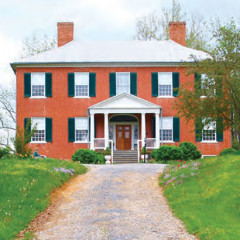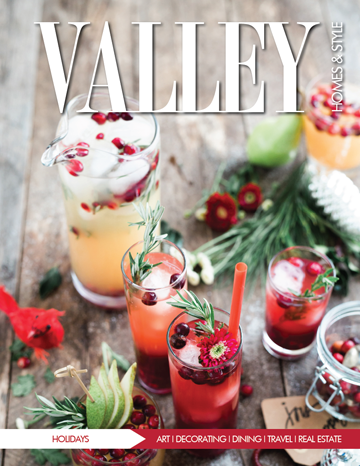Cao Lynchburg Chocolatiers
by Maggie Wolff Peterson It all started with a chick flick. Hungry for a hobby in which she might involve her husband, Mary Matice was inspired while watching the movie, “Chocolat.” Lushly romantic, the film features a tiny chocolate shop as the place where love takes hold. Matice got an idea. Small-batch chocolate, made impeccably, was something the she and her husband, Carl, could do together. That was four years ago. In November 2013, the couple opened Cao, a chocolate shop in Lynchburg that features their bars, bark, tasting squares and truffles. Once a teeming industrial port city and bastion of the Confederacy, today Lynchburg is home to Liberty University and an architecturally diverse, recovering downtown. Prior decades were unkind to downtown Lynchburg’s lofty, century-old brick warehouses, factories and mercantile stores, many of which remain underutilized. But recovery can be seen in a year-round farmer’s market, stylish new shops and restaurants that span from Halal Mediterranean to American comfort food. A former delicatessen, the 3,000-square-foot space now occupied by Cao retains the pressed-tin ceiling, globe pendant lighting, white subway tiles and original blackand- white linoleum floors of its predecessor. An enormous kitchen with two commercial ovens provides more than enough space to roast cacao beans. A fresh coat of deeply maroon paint — Mary Matice calls it “aubergine” — to match the wrappers on Cao chocolate bars, was almost all that was needed to renew the space. Mary Matice imagines converting a loft area at the back of the store for chocolate-making classes and educational displays. The main floor will be developed as a dessert lounge, where customers may enjoy pastries and fondue made with Cao chocolate, or attend tasting events that pair fine coffees or wine with chocolates. Counter service will provide customers with bars and boxed chocolates made onsite. Cao’s boutique chocolate will be different from most. It is not typical for a small retail chocolatier to begin with beans. Many boutique chocolatiers, even the most highend, begin with chocolate that has been made elsewhere and delivered in bulk. The candy makers then melt and reconfigure the bulk product for their specialty products. Not Cao. The Matices begin with the raw commodity. “I had never considered that you could do small-batch chocolate from the bean,” Mary Matice says. The purity of the process appealed to her. Each with diabetic tendencies, neither Mary nor Carl Matice was a big consumer of processed sweets. But taking cacao straight from the pod, roasting and hulling it, and then converting it to nibs and finally dark chocolate, allows them to control the recipe, the ingredients and the finished product. Their research...
Smithfield Farm
Seven-plus Generations and Going Strong by Debra Cornwell photos by Eric Fargo Local, modern American farmers deploy many talents and tactics, including creativity, diversity, and ingenuity, in developing and maintaining their business. Years ago, farmers, or members of their family, might have a side business, like hauling or handy work, to ensure year-round income. Today, that is no different, but the savvy farmer has kicked it up a notch. At Smithfield Farm, near Berryville, Va., the Smith descendants are perfecting that diversification with great success—a bed & breakfast, a farm with retail meat sales, a kitchen with prepared foods and an art studio. First cousins, 11-year-old Benson Weidemer and 9-year-old Linus Pritchard, are the rising eighth generation to one day own and operate Smithfield Farm. Benson’s mother, Betsy Pritchard, says, “We tell them, go and live your life, travel the world, but know that this is here for you, and the farm will be your responsibility one day.” The farm is nearing its 200th anniversary in the same family. Ruth Smith Pritchard took the reigns of Smithfield Farm in 1988. She and her three siblings inherited 1,500 acres in mostly Clarke County, Va., but some in Jefferson County, W.Va., along Wickcliffe Road. Two of her siblings still own their share and Ruth, along with her son Forrest and daughter Betsy, owns about 400 acres. Edward Smith purchased the farm in 1816, began building the barn in 1820, and started the large, Federal style home of Flemish bonded brick in 1822. Edward and his brother John had inherited the princely sum of $5,000 from a great aunt in England. He went on to build the fieldstone fortress of a house, Hackwood, near Winchester, which is visible along the east side of Interstate 81, just north of the Route 7 exit. The manor house is largely in original condition. “Our ancestors were not fancy; they were farmers, so they never had money for upgrades and renovations,” Betsy shares. “My parents took ten years to restore the house from the ground up.” Of working with family, Ruth reflects, “It is a dream come true to have our children want to come home and take up farming. I hoped they would want to continue what my late husband and I started, but didn’t want to pressure them or make them feel guilty if they needed to go elsewhere. It is a beautiful thing that Forrest and Betsy have returned to our idea of going back to the way my dad started out in the 1930s—i.e. organic—although it wasn’t called that. They’ve taken it so much farther than we ever dreamed. I love living...
Through the Front Door
A very merry retro Christmas By Lisa Bartell of Wisteria Cove Photos by Bethany Lowe Designs We live in a fast-paced society — a computer age where everything is at our fingertips at a touch of a button. Abundance seems to be the key to success and happiness. As humans our bodies and minds can’t operate at megahertz speed, bringing us unnecessary stress and frustration, especially during the Christmas holiday season. Let’s take a moment to slow down, sit back, unwind and relax. Imagine a much simpler time when children played outside with their friends not in front of a video game for hours. A time where everyone gathered around the family dinner table, enjoying a meal and talking about their day, not texting or eating on the run. A time when cards and letters were hand written and delivered by the good old United States Postal service, not by email. A time when the closest thing we had to the ever-present cell phone was a string with two cans tied to either end. Yes, holidays in the 1950s where less stressful. Little Suzie and Johnny only got one or two presents that didn’t cost an entire week’s salary. Christmas cookies were homemade from a family recipe. Families seemed to be much closer and valued the true meaning of Christmas, practicing time honored traditions. Join me as I show you some photos of 1950s holiday decor and fun facts of a 50s Christmas. Rockin around the Christmas tree With WWII ending in the mid 1940s, America was once again in the swing of things in the 1950s. Fresh evergreens were available; in fact over 30 million Christmas trees were sold in 1954 alone. If a fresh tree didn’t fit your lifestyle, you had a choice of an artificial green or white Christmas tree. If you were really ultra modern, you may try one of those new-fangled Aluminum tinsel trees with a revolving color wheel. Some said this new tree was so different, that it was sacrilege. During the war our glass ornaments from Germany had ceased. So America started producing many ornaments from plastic and Styrofoam. Even though glass ornaments starting coming over again in the 1950s, Americans still bought plastic ornaments because they were virtually unbreakable and they were very inexpensive. Plastic ornaments came in figural shapes of angels, bells, Santas and snowmen. Styrofoam balls often were covered in spun satin or covered in glitter. Glass balls that were popular during that time were mercury glass, giving off a brilliant shine. A popular light that was strung on the tree was a bubble light. It was a glass...
Great holiday Gingerbread men
Ginger Bread Men INGREDIENTS 1 cup packed brown sugar 1 1/2 stick butter, softened 2 eggs 1/2 cup molasses 1 teaspoon vanilla extract 4 cups flour, plus more for dusting 2 1/4 teaspoons ground ginger 1 1/2 teaspoons baking soda 3/4 teaspoon ground cinnamon 1/2 teaspoon freshly grated nutmeg 1/2 teaspoon ground cloves 1/2 teaspoon all-spice 1/4 teaspoon black pepper 1/2 teaspoon salt In a stand mixer, cream together the sugar and butter. Add the eggs, one at a time, until fully incorporated, and then add the molasses and vanilla extract. Sift together the dry ingredients in a bowl and slowly add to the egg mixture until evenly combined and a dough forms. Wrap the dough in plastic wrap and refrigerate for at least 1 hour until firm. Divide the dough into halves and roll out each half at a time onto a floured work surface. Roll until the dough is -inch thick and cut out the gingerbread men. Lay them out on baking sheets lined with parchment paper. Repeat steps with the dough scraps and the other half of dough. Preheat oven to 350 degrees. Bake in the oven for 10 minutes, until the edges are browned. Decorate the cookies using icing, sprinkles, and other candies. Maple Gingerbread and Cranberry Brie Bites Sugared Cranberries 2 cups fresh cranberries 1 cup good maple syrup 1 cup granulated sugar Rinse cranberries and place in a medium bowl. Heat syrup in a small sauce pan just until warm. Pour over cranberries when syrup is warm, not hot, or cranberries may pop. Cool, cover, and let soak in the refrigerator overnight. Drain cranberries in a colander, reserving liquid for later use. Place sugar in a large bowl or baking dish. Add cranberries in 2 batches and roll around until lightly coated in sugar. Place on a baking sheet until dry, about 1 hour. Assembly 20 round gingerbread cookies, plain, undecorated 8 oz brie cheese sugar dusted cranberries maple cranberry syrup fresh mint for garnish Assemble gingerbread cookies with one slice of brie, a light layer of the reserved maple cranberry syrup, and 4 or 5 sugared cranberries. Garnish with fresh mint...
Mixing Shine at The Bootleg Bar
By Margo Williams Our region is one of the best areas for farm to table and enjoying local fare. Just in time for celebrating the season, how about farm to still to bottle? Locally grown black walnuts, corn, ginger, peaches, pumpkins, raspberries and even lemons are a few of the components to craft a perfect cocktail Rob and Linda Losey have the perfect product “moonshine” made exclusively in the hills of West Virginia. This isn’t like the hard liquor of yesteryear. Sweet shine is just that: sweet, smooth and mellow. It’s fabulous on its own as a cordial or mixed with regular liquor crafting an unforgettable cocktail. Bloomery Plantation’s Premiere Mixologist, Eric Bell, a self proclaimed “foodie” loves to handcraft cocktails based on seasonal favorite flavors. “I like to craft unique cocktails based on the customers’ favorite foods, says Bell. Eric was on hand to create some special holiday inspired, hand crafted cocktails at a favorite landmark in Charles Town, W.Va., the remixed Bootleg Bar, a sophisticated journey back to the vintage 1970s when cocktails were cool. The Bootleg Bar has become Charles Town’s Cocktail Playground. This new favorite hang out is retro and as vintage in design as it gets. With Ronnie and Duane Marcus, a dynamic forward thinking father-son team, the old Bootleg Bar is seeing a total redo exclusively handcrafting cocktails using products from Bloomery Plantation Distillery. “This is as good as it gets,” says Ronnie Marcus. “A sophisticated place to meet with friends and family to enjoy a premium cocktail, something unique. Linda Losey agrees: “This is the perfect venue for Baby Boomers and their adult children to be cool together, mix up and remix up long favored cocktails for today.” And it doesn’t get better than locally grown flavors, added spices, shaken, stirred or served straight up. The Bootleg is located inside The Turf Restaurant. The Turf was founded in the 1950s and has been a landmark ever since. It specializes in regional favorites including being voted for the “Best Prime Rib” in the area. The Turf Restaurant’s Executive Chef for over ten years, Sean Deblois, is excited about the new endeavor. He is currently working on a bar or tapas (small plate) menu to complement the flavors of the cocktails that can be changed seasonally to capture the true taste and essence of each season. The Bootleg will celebrate its grand reopening after many years on the weekend of December 7th — just in time for the holidays. The celebration also commemorates the December 5th, 1933 date when the Prohibition Era ended with the 21st Amendment. Take a break from holiday shopping, pull...






